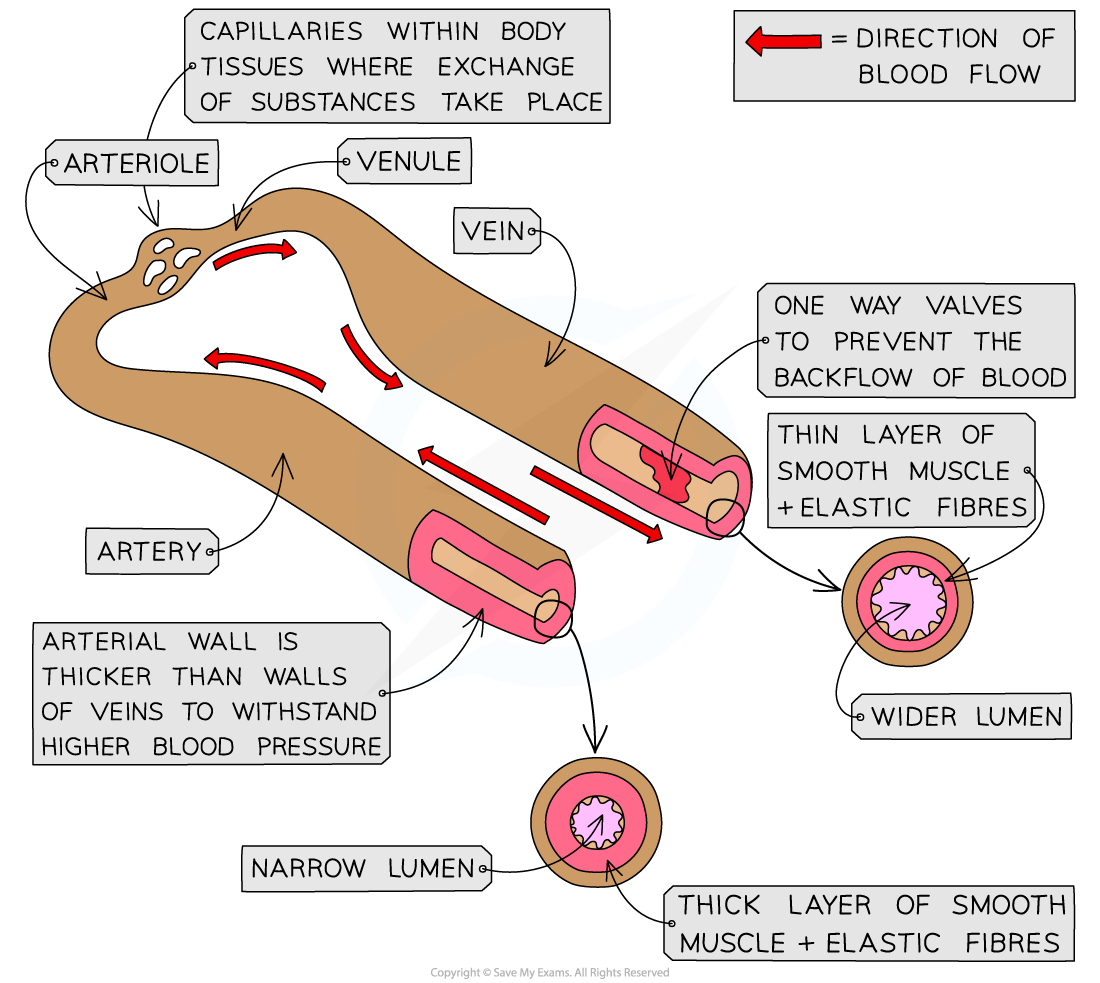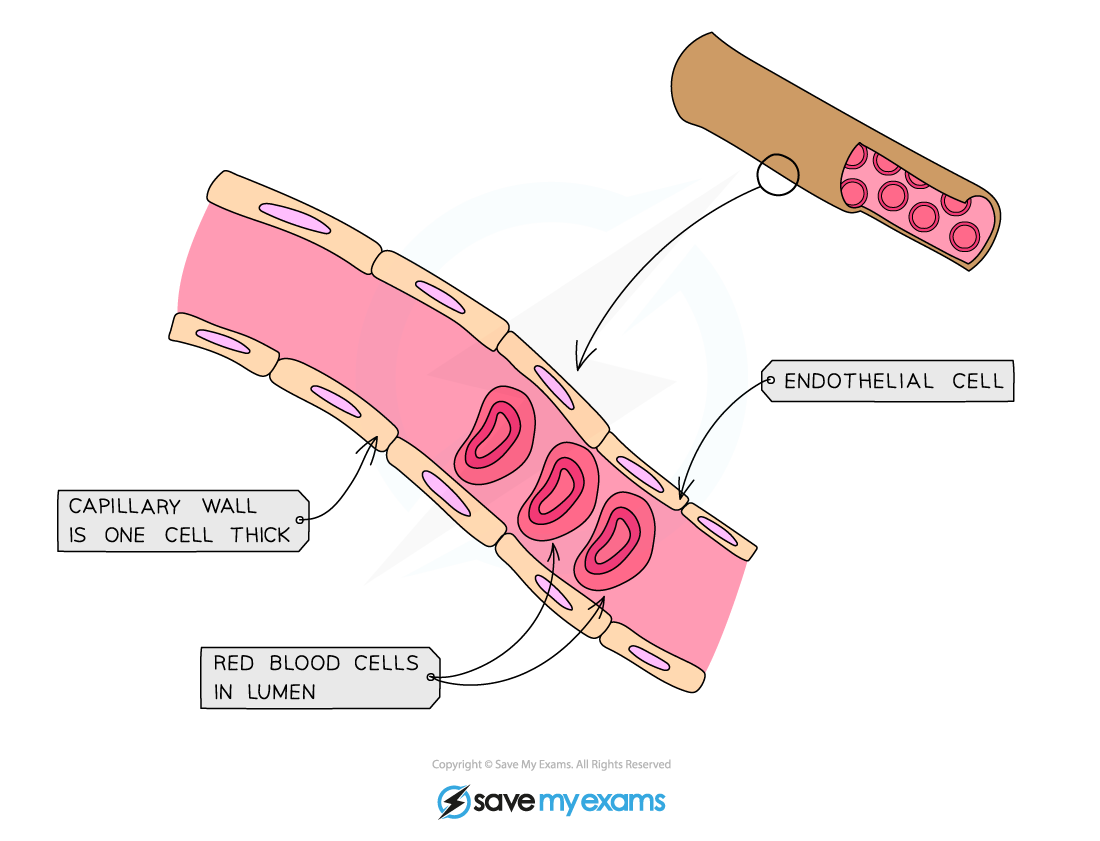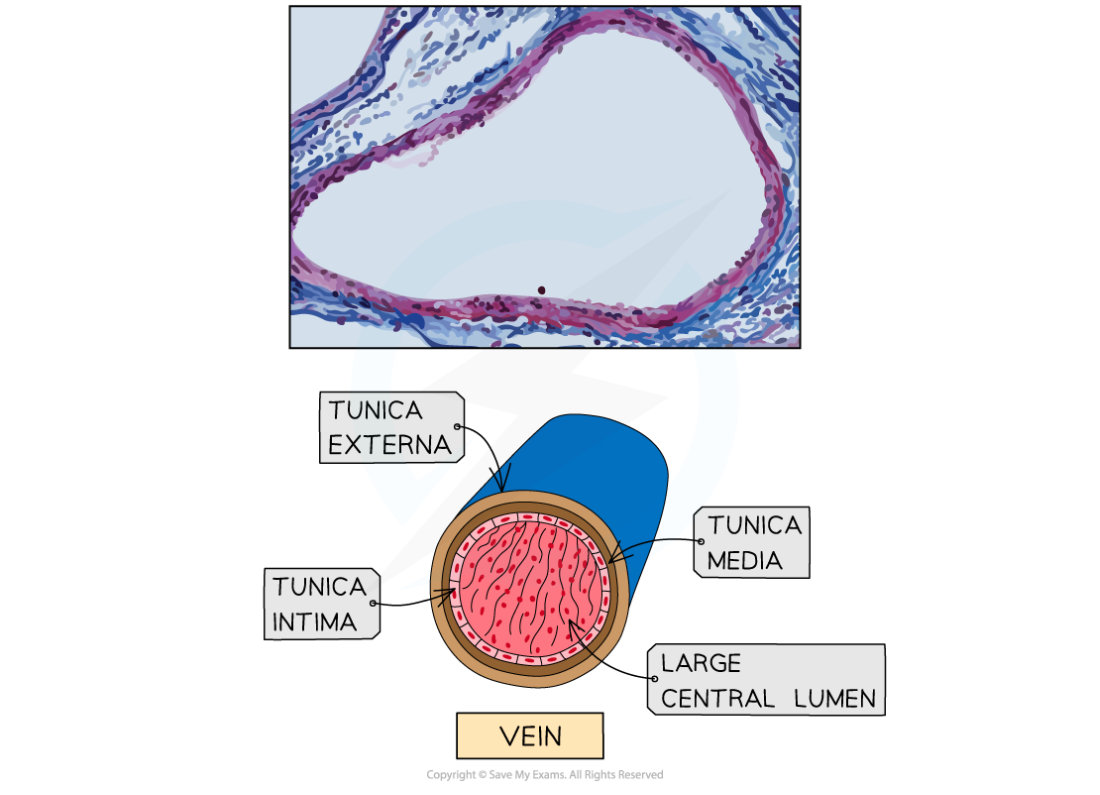Arteries
Introduction to blood vessels
- The circulatory system of the human body contains several different types of blood vessel:
- Arteries
- Arterioles
- Capillaries
- Venules
- Veins
- Each type of blood vessel has a specialised structure that relates to the function of that vessel

The circulatory system includes several blood vessels, each specialised to carry out its function
Structure and function of arteries
- Arteries transport blood away from the heart at high pressure
- Blood travels from the ventricles to the tissues of the body
- Remember; arteries carry blood away from the heart
- Artery walls consist of three layers:
- The tunica intima is the innermost layer and is made up of an endothelial layer, a layer of connective tissue and a layer of elastic fibres
- The endothelium is one cell thick and lines the lumen of all blood vessels. It is very smooth and reduces friction for free blood flow
- The tunica media is made up of smooth muscle cells and a thick layer of elastic tissue
- Arteries have a thick tunica media
- The layer of muscle cells strengthen the arteries so they can withstand high pressure
- Blood leaves the heart under high pressure
- Muscles cells can also contract or relax to control the diameter of the lumen and regulate blood pressure
- The elastic tissue helps to maintain blood pressure in the arteries. It stretches and recoils to even out fluctuations in pressure
- The tunica externa covers the exterior of the artery and is mostly made up of collagen
- Collagen is a strong protein and protects blood vessels from damage by over-stretching
- The tunica intima is the innermost layer and is made up of an endothelial layer, a layer of connective tissue and a layer of elastic fibres
- Arteries have a narrow lumen which helps to maintain a high blood pressure
- A pulse is present in arteries due to blood leaving the heart under high pressure

Arteries have thick muscular walls made up of three layers of tissue and a narrow lumen
Structure and function of arterioles
- Arterioles branch off from arteries forming narrower blood vessels which transport blood into capillaries
- Arterioles are similar in structure to arteries, but they have a lower proportion of elastic fibres and a large number of muscle cells
- The presence of muscle cells allows them to contract and close their lumen to regulate blood flow to specific organs
- Eg. during exercise blood flow to the stomach and intestine is reduced while blood flow to the muscles increases
Arterial blood pressure
- Arteries, and to a slightly lesser extent arterioles, must be able to withstand high pressure generated by the contracting heart, and both must maintain this pressure when the heart is relaxed
- Muscle and elastic fibres in the arteries help to maintain the blood pressure as the heart contracts and relaxes
- Systolic pressure is the peak pressure point reached in the arteries as the blood is forced out of the ventricles at high pressure
- At this point, the walls of the arteries are forced outwards, enabled by the stretching of elastic fibres
- Diastolic pressure is the lowest pressure point reached within the artery as the heart relaxes
- At this point, the stretched elastic fibres recoil and force the blood onward through the lumen of the arteries
- This maintains high pressure throughout the heart beat cycle
- Systolic pressure is the peak pressure point reached in the arteries as the blood is forced out of the ventricles at high pressure
- Vasoconstriction of the circular muscles of the arteries can increase blood pressure by decreasing the diameter of the lumen
- Vasodilation of the circular muscles causes blood pressure to decrease by increasing the diameter of the lumen
Exam Tip
Be careful with the language you use to describe the roles of muscle and elastic tissue; muscle can contract and relax, while elastic tissue can stretch and recoil.
Capillaries
Structure and function of capillaries
- Capillaries provide the exchange surface in the tissues of the body through a network of vessels called capillary beds
- The wall of a capillary is made from a single layer of endothelial cells (this layer is also found lining the lumen in arteries and veins)
- Being just one cell thick reduces the diffusion distance for oxygen and carbon dioxide between the blood and the tissues of the body
- The thin endothelium cells also have gaps between them called pores which allow blood plasma to leak out and form tissue fluid
- Tissue fluid contains oxygen, glucose and other small molecules from the blood plasma
- Large molecules such as proteins usually can't fit through the pores into the tissue fluid
- Tissue fluid surrounds the cells, enabling exchange of substances such as oxygen, glucose, and carbon dioxide
- The permeability of capillaries can vary depending on the requirements of a tissue
- Capillaries have a lumen with a small diameter
- Red blood cells squeeze through capillaries in single-file
- This forces the blood to travel slowly which provides more opportunity for diffusion to occur
- Capillaries form branches in between the cells; this is the capillary bed
- These branches increase the surface area for diffusion of substances to and from the cells
- Being so close to the cells also reduces the diffusion distance
- The wall of a capillary is made from a single layer of endothelial cells (this layer is also found lining the lumen in arteries and veins)

Capillaries have a narrow lumen and walls that are one cell thick
Veins
Structure and function of veins
- Veins transport blood to the heart at low pressure
- Remember; veins carry blood into the heart
- They receive blood that has passed through capillary networks, across which pressure has dropped due to the slow flow of blood
- The structure of veins differs from arteries:
- The tunica media is much thinner in veins
- There is no need for a thick muscular and elastic layer as veins don't have to maintain or withstand high pressure
- The lumen of veins is much wider in diameter than that of arteries
- A larger lumen helps to ensure that blood returns to the heart at an adequate speed
- A large lumen reduces friction between the blood and the endothelial layer of the vein
- The rate of blood flow is slower in veins but a larger lumen means the volume of blood delivered per unit of time is equal
- Veins contain valves
- These prevent the back flow of blood that can result under low pressure, helping return blood to the heart
- Movement of the skeletal muscles pushes the blood through the veins, and any blood that gets pushed backwards gets caught in the valves; this blood can then be moved forwards by the next skeletal muscle movement
- The tunica media is much thinner in veins
- A pulse is absent in veins; the pressure changes taking place due to the beating of the heart are no longer present

Veins have a structure similar to arteries with three layers of tissue and a large lumen
Structure and function of venules
- Venules connect the capillaries to the veins
- They have few or no elastic fibres and a large lumen
- As the blood is at low pressure after passing through the capillaries there is no need for a muscular layer to maintain pressure
- The large lumen enables a large volume of blood to be transported
Exam Tip
For “Explain” questions, remember to pair a description of a structural feature to an explanation of how it helps the blood vessel to function. For example, “Capillaries have walls that are one-cell thick, enabling quick and efficient diffusion of substances due to a short diffusion distance."
